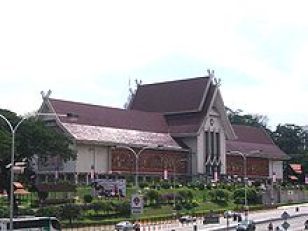National Museum
Jalan Damansara, 50566 Wilayah Persekutuan, Wilayah Persekutuan Kuala Lumpur, Malaysia
Phone : +60 3-2267 1111
The National Museum is a museum located on Jalan Damansara in Kaula Lumpur, Malaysia. The museum is situated in close proximity to the Perdana Lake Gardens and it provides an overview of Malaysian history and culture. National Museum was opened on 31 August 1963, and it serves as a repository of Malaysia’s rich cultural and historical heritage.
The National Museum is a three-story structure of 109.7 meters long and 15.1 meters wide and 37.6 meters at the central point. Adorning the floor of the Central Hall are blue geometric-design mosaic tiles from Pakistan, with intricate carved panels on the ceiling of the hall.
In the vicinity of the National museum building, there are a number of outdoor displays of transportation in Malaysia, past and present. An interesting exhibit is the Melaka Bullock Cart which closely resembles the early American horse-drawn wagon. Of unparalleled interest are the Steam Locomotive made by Kitson & Co., England, which was put into service in 1921 until it ceased operation in 1969. It covered 1.5 million rail miles; a Tin Dredge which resembles a floating factory, on a natural or artificial lake. Also on display are motorised vehicles, including antiqued civic vehicles and private vehicles, including an early 1.3 litre Proton Saga, the first national car launched on 18 April 1985.

Istana Satu
Another attraction of the Museum is an original-size old Terengganu timber palace known as Istana Satu. It was erected by Sultan Zainal Abidin III, Sultan of Terengganu in 1884 in the compound of Kota Istana Maziah, Kaula Terengganu. This building is of Terengganu Malay traditional architecture, in the form called “Rumah Tiang Dua Belas”. The wood used is cengal. Istana Satu was erected in the National Museum compound in April 1974.

Rich Malay craftsmanship is evident throughout the palace, from the intricate wood carvings that adorn doors and windows. The restored palace is a charming wooden house designed for the tropics. Standing on stilts that allow air to circulate freely under the building, the palace’s steep thatch roof contributes further to keeping the interior of the house nice and cool.
Standing majestically next to the Istana Satu are two keliriengs or burial poles. A kelirieng is made of a huge hardwood tree trunk, carved from the top to bottom. Niched up to its sides is a space for the bodies of slaves and followers and hollowed at the top to place the jar containing the chief’s bones.
Source : Wikipedia
https://www.youtube.com/watch?v=0so26dhFpcg
https://www.youtube.com/watch?v=GQu590GUMfo
Reviews
Opening hours : 09.00AM to 06.00PM It is closed on the first day of Hari Raya Aidilfitri and Hari Raya Aidil Adha.
Entrance fee :RM 2 for adult Indians (Children below 12 years old do not have to pay. Free entrance is also given to children in school uniforms.)
For foreign tourists : RM5 for adult and RM2 for children 6-12 years old.
Getting there : Take the Kelana Jaya Line LRT, KL Monorail or KTM Komuter train and stop at KL Sentral Station. Use the pedestrian walking pathway and the museum can be reached in 15 minutes.
Another alternative is to take the KL Hop-in Hop-Off bus specially designed for tourists and stop at the museum at bus stop number 12.



Rate this article